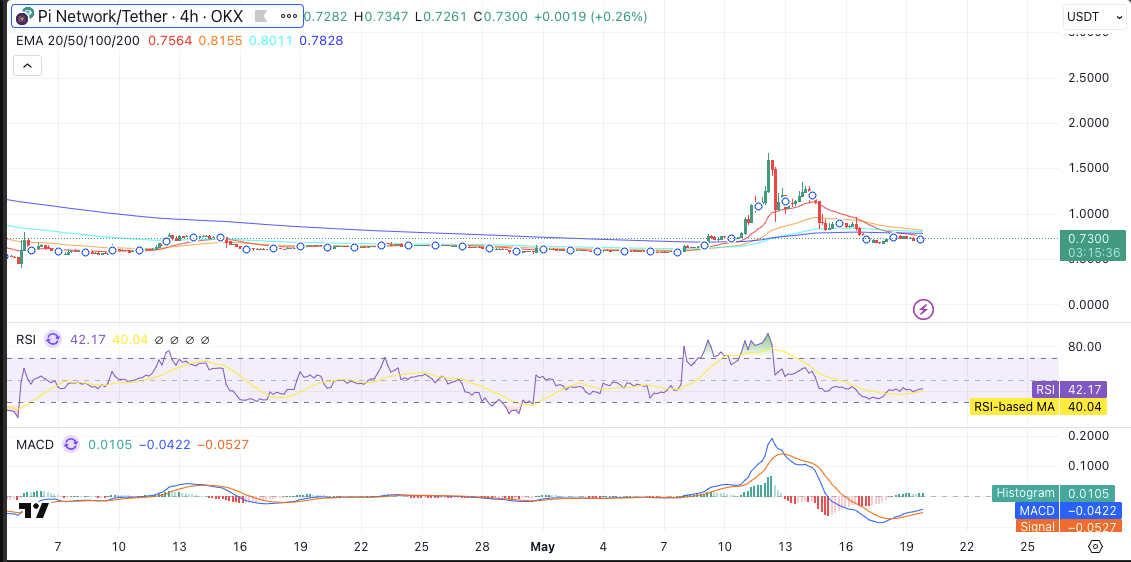Key Insights:
- Pi Coin has dropped over 50% in the past week and is now trading near $0.70.
- A total of 5.7 million Pi Coin tokens is unlocking today, which may increase selling pressure.
- The number of Pi Coin tokens on exchanges has reached a record high of 397 million.
Pi Coin has been facing strong selling pressure. Its price has dropped over 50% in the past week. Currently, it trades near $0.70.
Investors are worried about further declines. Today, 5.7 million tokens will be unlocked. This could add even more downward pressure.
Pi Coin Faces Pressure as Supply Increases and Exchange Holdings Reach New High
The current number of Pi Coins being unlocked could lead to a substantial rise in the number of Pi Coins available for trading. As a result, increased supply could result in more people selling their tokens. For this reason, the price of Pi Coin could keep dropping all day.
On the other hand, the amount of Pi Coin deposited on exchanges has jumped to 397 million. This means many token owners plan to sell or trade their cryptos. When new coins are unlocked, the exchanges’ reserves may increase.
The sudden increase in these tokens suggests that people’s beliefs about the market are changing. Though some people favor the project, others are ready to leave. Should new demand for Pi Coin stay the same, the rise in supply could significantly lower the coin’s value.
Pi Coin Transparency Faces Growing Doubts
Dr. Altcoin spoke out and raised doubts about the transparency of Pi Network’s operations. He mentioned that the team is responsible for over 10,000 wallets and sub-wallets. Still, individuals can only trace the actions of the seven largest wallets.
So far, the Core Team has not worked on clarifying the transparency problem with wallets. Currently, members of the Pi Coin community disagree about the project’s claims and future. A few supporters remain loyal, whereas some fans are asking for answers.
Dr. Altcoin questioned whether some people support the Core Team because they are connected. He urged that more transparent and stronger supervision be implemented. The debate is fueling uncertainty about how long Pi Coin can continue operating.
Lack of Major Exchange Listings Raises Doubts About Pi Coin’s Future
Many members of the Pi Coin community have asked Binance and other major exchanges to add support for Pi. A survey conducted in February showed that most people were in favor of this action. Still, supporters are disappointed that things have not moved forward as expected.
Regardless of the vocal support from the community, the major platforms have not agreed to list crypto coins. Binance might take more time to add this token as it follows strict guidelines. Since these markets are not open for the token, its exposure and trading are much lower.
The Core Team has started concentrating on growing the ecosystem and has launched Pi Network Ventures with $100 million in funds. However, people had differing opinions, since some expected the project to list on major exchanges sooner. The community becomes even less satisfied as the token’s price goes down.
Pi Coin Struggles Below Key Averages
Pi Coin’s hourly chart shows that the token trades beneath these exponential moving averages, including the 20, 50, 100, and 200 EMAs, which also provide resistance. The current trend suggests that investors believe the market is going downward.
According to the RSI, which is 42.17, the token is currently in between neutral and bearish zones. The moving average based on the Relative Strength Index is lagging, suggesting buyers are uninterested. This situation signals that more downside could occur if the overall market volume does not change noticeably.

When the MACD line is a little above the signal line, a trend shift may occur. Yet, the market remains quiet, which can be understood from the flatness of the histogram. As long as things do not pick up quickly, the price of Pi Coin may continue to weaken.
